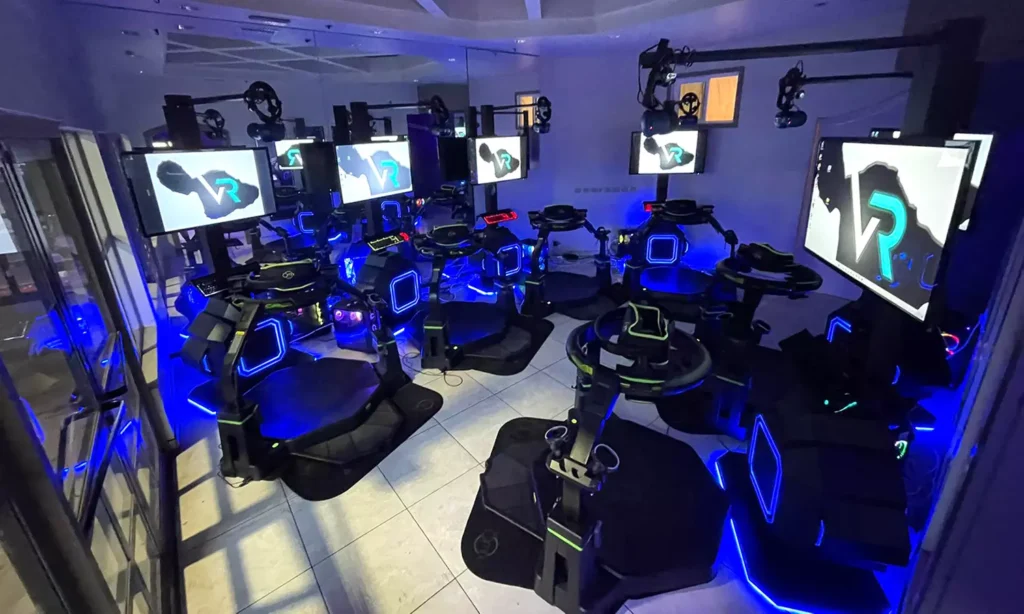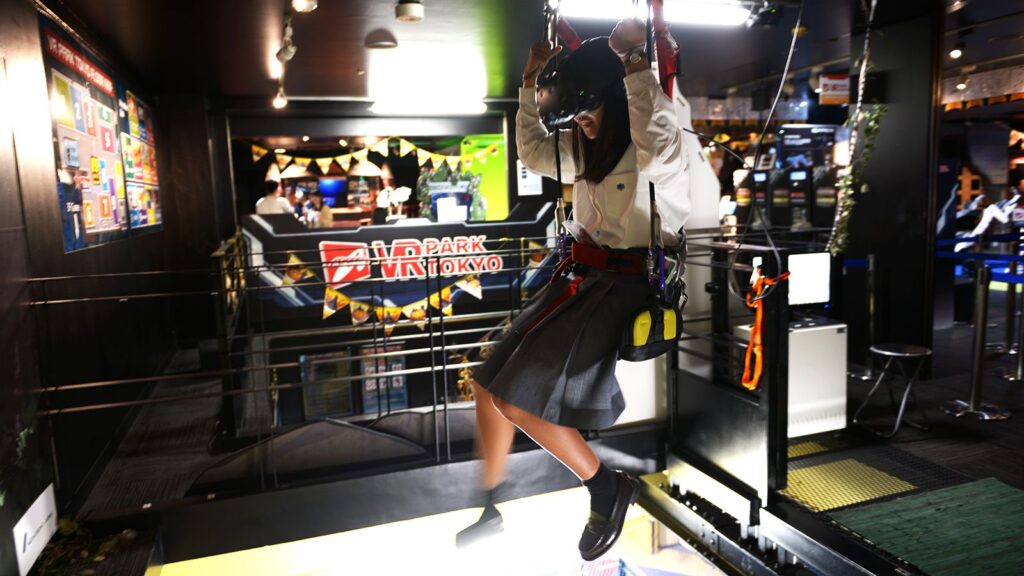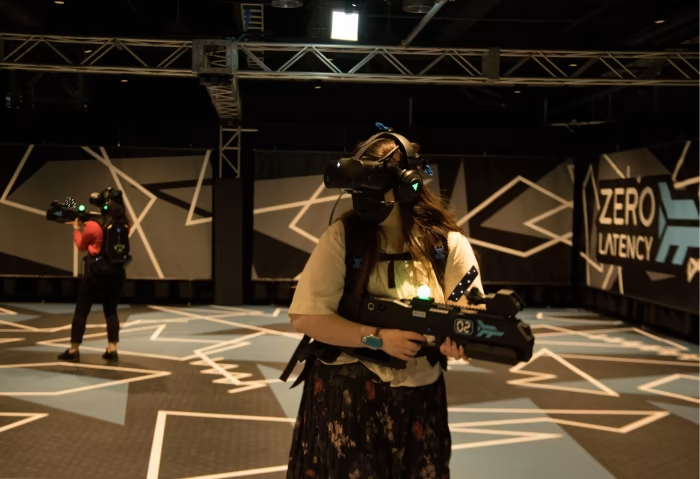Tokyo, Japan, is at the forefront of gaming innovation, and VR gaming lounges are its latest marvel. These futuristic hubs offer an unparalleled blend of immersive gaming experiences and competitive esports action. But are these VR gaming lounges just a passing trend, or do they signal the future of esports? Let’s dive into the technology, the business model, and their potential to revolutionize competitive gaming.
What Are VR Gaming Lounges?
VR gaming lounges are physical spaces equipped with high-end virtual reality gear, offering gamers access to immersive experiences that are impossible to replicate at home. In Tokyo, these lounges are designed with cutting-edge technology, spacious play areas, and a variety of games that cater to both casual gamers and competitive esports players.
Key Features of Tokyo’s VR Gaming Lounges:
- High-Tech VR Equipment: Featuring the latest VR headsets like the Meta Quest Pro and HTC Vive Pro, these lounges ensure smooth gameplay with minimal latency.
- Haptic Feedback Systems: Some lounges incorporate body suits and gloves with haptic feedback, allowing players to feel in-game actions like punches or environmental changes.
- Custom-Built Arenas: With spacious arenas, players can roam freely, making the experience more immersive.
- Multiplayer Support: Many lounges are equipped to host multiplayer games, which is crucial for the esports potential of VR gaming.
How Do VR Gaming Lounges Work?
The operational model of VR gaming lounges combines pay-per-session gameplay with membership subscriptions. Here’s a breakdown of how they function:
- Game Variety: Lounges offers a range of games, from first-person shooters to puzzle-based adventures. Popular titles include “Beat Saber,” “Half-Life: Alyx,” and team-based games like “Echo VR.”
- Hourly or Subscription Pricing: Players can pay per hour or subscribe for unlimited monthly access. Costs typically range from ¥2,000 to ¥5,000 per hour, depending on the technology and games offered.
- Event Hosting: Some lounges double as event venues, hosting VR esports tournaments that attract players and spectators alike.
What Does a Typical VR Gamer Spend?
One of the most common questions about VR gaming lounges in Tokyo is how much it costs to enjoy a session. While prices vary depending on the venue, technology, and duration, here’s a breakdown of typical expenses for both casual visitors and regular patrons:
Daily Costs
For a single day of gaming, visitors typically pay for sessions by the hour. Here’s what you can expect:
- Hourly Rates: Most VR gaming lounges charge between ¥2,000 to ¥5,000 ($15 to $35 USD) per hour. High-end lounges with cutting-edge technology and premium experiences, such as full-body tracking or haptic suits, may charge on the higher end.
- Add-ons: Some lounges offer optional extras like enhanced VR gear (e.g., haptic gloves, upgraded headsets) or access to exclusive game titles, which can cost an additional ¥500 to ¥2,000 ($4 to $15 USD) per session.
- Refreshments: Many lounges have cafes or vending machines, so adding a drink or snack to your visit could cost another ¥500 to ¥1,000 ($4 to $8 USD).
Estimated Daily Cost: For a two-hour session with some extras, expect to spend around ¥6,000 to ¥10,000 ($40 to $70 USD).
Monthly Costs
For dedicated gamers or locals who frequent VR gaming lounges, membership plans and subscription models are more cost-effective:
- Membership Plans: Many lounges offer memberships ranging from ¥10,000 to ¥25,000 ($70 to $175 USD) per month, providing unlimited or discounted access.
- Exclusive Perks: Memberships often come with perks such as priority bookings, free add-ons, or access to members-only events and tournaments.
- Longer Sessions: Some memberships allow for extended sessions, making them ideal for those who want to explore VR worlds or hone their esports skills without feeling rushed.
Estimated Monthly Cost: On average, regular VR gamers can expect to spend ¥15,000 to ¥30,000 ($105 to $210 USD) per month if they visit multiple times a week.
Is It Worth It?
For casual visitors, VR gaming lounges offer a unique, unforgettable experience at a reasonable cost. For serious gamers or esports enthusiasts, the monthly investment provides access to advanced equipment, exclusive content, and a community of like-minded players, making it a worthwhile expense.
Whether you’re planning a single session or considering a membership, Tokyo’s VR gaming lounges cater to a range of budgets while delivering cutting-edge entertainment.
The Business Model: Why Tokyo is the Perfect Fit
Tokyo’s thriving tech ecosystem and densely packed population make it the ideal breeding ground for VR gaming lounges. With space at a premium, many residents lack room for VR setups at home, making these lounges an attractive alternative.
Revenue Streams:
- Hourly Fees and Subscriptions: Steady income from local gamers and tourists.
- Corporate Sponsorships: Tech giants often sponsor these lounges to showcase their latest VR hardware.
- Esports Events: Ticket sales, live-streaming revenue, and prize pools contribute significantly to the business model.
The Impact on Esports
One of the most exciting aspects of VR gaming lounges is their potential to shape the future of esports. Traditional esports rely on consoles and PCs, but VR gaming introduces a new level of physicality and immersion.
Benefits of VR in Esports:
- Increased Viewer Engagement: Spectators can watch players’ live VR feeds or experience the game themselves via spectator modes.
- Physical Fitness: Unlike traditional esports, VR gaming requires players to move their bodies, potentially broadening the appeal of esports to a wider audience.
- Innovation in Gameplay: Games designed for VR allow for creative mechanics that don’t exist in traditional formats, such as climbing, throwing, or tactile interaction.
Are VR Gaming Lounges Accessible?
While VR gaming lounges in Tokyo offer unparalleled experiences, they remain a premium service. The cost of entry can be a barrier for some, especially when compared to traditional gaming cafes. However, many lounges are working to make VR gaming more accessible through group discounts and off-peak pricing.
Tips for Visitors:
- Advance Booking: Popular lounges like VR Park Tokyo and Tyffonium often require reservations.
- Beginner Tutorials: Many lounges offer tutorials for newcomers, making VR gaming accessible to first-timers.
Challenges Facing VR Gaming Lounges
Despite their potential, VR gaming lounges face several hurdles:
- High Operational Costs: Maintaining cutting-edge VR equipment and spacious facilities is expensive.
- Limited Game Selection: While the number of VR games is growing, it still lags behind traditional platforms.
- Motion Sickness: VR’s immersive nature can cause discomfort for some players, limiting its audience.
Notable VR Gaming Lounges in Tokyo
- VR Park Tokyo: Located in Shibuya, this lounge offers a mix of adventure games and multiplayer titles.
- Tyffonium: Known for its cinematic VR experiences, Tyffonium is a favorite for tourists.
- VREX Akihabara: This lounge caters to competitive gamers with its focus on multiplayer esports.
Why Tokyo Loves VR Gaming Lounges
Japanese culture has long embraced innovation and community-centered activities, making VR gaming lounges a natural fit. These spaces provide not just entertainment but also a way for people to socialize, compete, and explore new technology.
Are VR Gaming Lounges the Future of Esports?
Tokyo’s VR gaming lounges are more than just a tech trend—they represent the next frontier in gaming and esports. While challenges like cost and accessibility remain, the immersive experiences they offer could redefine how we think about competitive gaming. Whether you’re a seasoned gamer or a curious tourist, these lounges promise an unforgettable dive into the future of gaming.
For Tokyo’s tech-savvy locals and visitors alike, VR gaming lounges are the ultimate playground for pushing the boundaries of what’s possible in esports and interactive entertainment.




